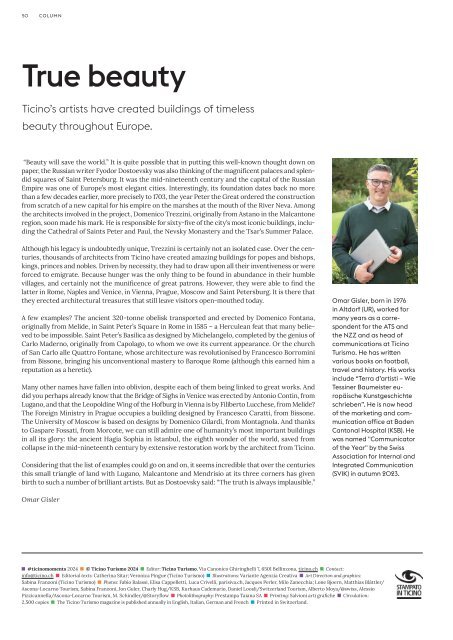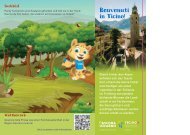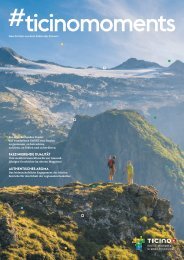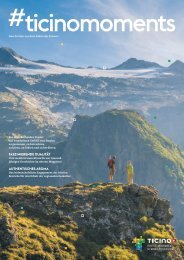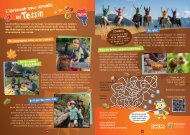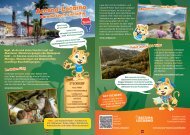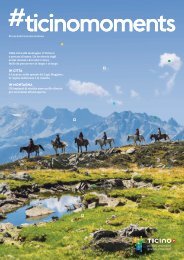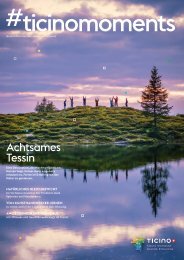#ticinomoments 2024
- No tags were found...
Create successful ePaper yourself
Turn your PDF publications into a flip-book with our unique Google optimized e-Paper software.
50<br />
COLUMN<br />
True beauty<br />
Ticino’s artists have created buildings of timeless<br />
beauty throughout Europe.<br />
“Beauty will save the world.” It is quite possible that in putting this well-known thought down on<br />
paper, the Russian writer Fyodor Dostoevsky was also thinking of the magnificent palaces and splendid<br />
squares of Saint Petersburg. It was the mid-nineteenth century and the capital of the Russian<br />
Empire was one of Europe’s most elegant cities. Interestingly, its foundation dates back no more<br />
than a few decades earlier, more precisely to 1703, the year Peter the Great ordered the construction<br />
from scratch of a new capital for his empire on the marshes at the mouth of the River Neva. Among<br />
the architects involved in the project, Domenico Trezzini, originally from Astano in the Malcantone<br />
region, soon made his mark. He is responsible for sixty-five of the city’s most iconic buildings, including<br />
the Cathedral of Saints Peter and Paul, the Nevsky Monastery and the Tsar’s Summer Palace.<br />
Although his legacy is undoubtedly unique, Trezzini is certainly not an isolated case. Over the centuries,<br />
thousands of architects from Ticino have created amazing buildings for popes and bishops,<br />
kings, princes and nobles. Driven by necessity, they had to draw upon all their inventiveness or were<br />
forced to emigrate. Because hunger was the only thing to be found in abundance in their humble<br />
villages, and certainly not the munificence of great patrons. However, they were able to find the<br />
latter in Rome, Naples and Venice, in Vienna, Prague, Moscow and Saint Petersburg. It is there that<br />
they erected architectural treasures that still leave visitors open-mouthed today.<br />
A few examples? The ancient 320-tonne obelisk transported and erected by Domenico Fontana,<br />
originally from Melide, in Saint Peter’s Square in Rome in 1585 – a Herculean feat that many believed<br />
to be impossible. Saint Peter’s Basilica as designed by Michelangelo, completed by the genius of<br />
Carlo Maderno, originally from Capolago, to whom we owe its current appearance. Or the church<br />
of San Carlo alle Quattro Fontane, whose architecture was revolutionised by Francesco Borromini<br />
from Bissone, bringing his unconventional mastery to Baroque Rome (although this earned him a<br />
reputation as a heretic).<br />
Many other names have fallen into oblivion, despite each of them being linked to great works. And<br />
did you perhaps already know that the Bridge of Sighs in Venice was erected by Antonio Contin, from<br />
Lugano, and that the Leopoldine Wing of the Hofburg in Vienna is by Filiberto Lucchese, from Melide?<br />
The Foreign Ministry in Prague occupies a building designed by Francesco Caratti, from Bissone.<br />
The University of Moscow is based on designs by Domenico Gilardi, from Montagnola. And thanks<br />
to Gaspare Fossati, from Morcote, we can still admire one of humanity’s most important buildings<br />
in all its glory: the ancient Hagia Sophia in Istanbul, the eighth wonder of the world, saved from<br />
collapse in the mid-nineteenth century by extensive restoration work by the architect from Ticino.<br />
Considering that the list of examples could go on and on, it seems incredible that over the centuries<br />
this small triangle of land with Lugano, Malcantone and Mendrisio at its three corners has given<br />
birth to such a number of brilliant artists. But as Dostoevsky said: “The truth is always implausible.”<br />
Omar Gisler, born in 1976<br />
in Altdorf (UR), worked for<br />
many years as a correspondent<br />
for the ATS and<br />
the NZZ and as head of<br />
communications at Ticino<br />
Turismo. He has written<br />
various books on football,<br />
travel and history. His works<br />
include “Terra d’artisti – Wie<br />
Tessiner Baumeister europäische<br />
Kunstgeschichte<br />
schrieben”. He is now head<br />
of the marketing and communication<br />
office at Baden<br />
Cantonal Hospital (KSB). He<br />
was named "Communicator<br />
of the Year" by the Swiss<br />
Association for Internal and<br />
Integrated Communication<br />
(SVIK) in autumn 2023.<br />
Omar Gisler<br />
<strong>#ticinomoments</strong> <strong>2024</strong> © Ticino Turismo <strong>2024</strong> Editor: Ticino Turismo, Via Canonico Ghiringhelli 7, 6501 Bellinzona, ticino.ch Contact:<br />
info@ticino.ch Editorial texts: Catherina Sitar; Veronica Pingue (Ticino Turismo) Illustrations: Variante Agenzia Creativa Art Direction and graphics:<br />
Sabina Franzoni (Ticino Turismo) Photos: Fabio Balassi, Elisa Cappelletti, Luca Crivelli, parisiva.ch, Jacques Perler, Milo Zanecchia; Lone Bjoern, Matthias Blättler/<br />
Ascona-Locarno Tourism, Sabina Franzoni, Jon Guler, Charly Hug/KSB, Kurhaus Cademario, Daniel Loosli/Switzerland Tourism, Alberto Moya/@swiss, Alessio<br />
Pizzicannella/Ascona-Locarno Tourism, M. Schindler/@Storyflow Photolithography: Prestampa Taiana SA Printing: Salvioni arti grafiche Circulation:<br />
2,500 copies The Ticino Turismo magazine is published annually in English, Italian, German and French Printed in Switzerland.


